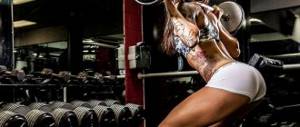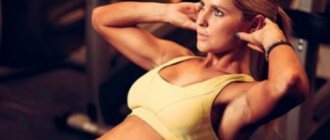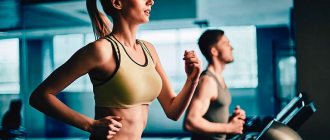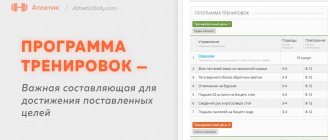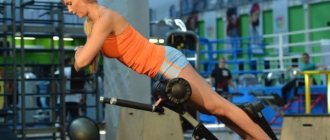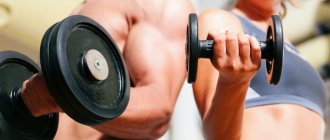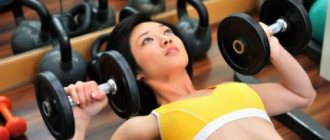Safety rules in the gym material on physical education (grades 9, 10, 11) on the topic
Safety rules in the gym
Before starting a lesson, consult with a trainer
Train only in sportswear and shoes (sneakers). Most ankle injuries occur when exercising while not wearing athletic shoes.
It is forbidden to practice with a naked torso.
Don't get distracted while doing the exercises. Do not talk or ask questions to the person doing the exercise at this time. Don't get distracted while doing the exercises.
Respect others.
Maintain personal hygiene. Do not use perfume with a strong smell before training, it may disturb others. Do not use the machine unless you are working on it or resting for a long time between sets. Lay down a towel to avoid leaving traces of sweat on the machine.
If you feel unwell, contact your gym instructor immediately
Keep the room clean and tidy. Do not throw discs and dumbbells around. After completing the exercise, return them to their place. When disassembling a bar standing on racks, remove the discs alternately (one disc on one side, then one on the other). Overweight by 30 kg at one end of the barbell can lead to a fall.
Be sure to start each workout with a warm-up. Warm up thoroughly: cardio (5-10 min.), stretching muscles and tendons. A general warm-up warms up the muscles, increases the elasticity of ligaments and tendons, and smoothly prepares the body for subsequent work.
Check the serviceability and reliability of the installation and fastening of the simulators used in training.
If a malfunction occurs in the operation of the simulator or it breaks down, stop exercising on the simulator and immediately notify the trainer on duty.
Maintain discipline and strictly follow the rules for using exercise equipment, taking into account their design features.
Monitor the correct technique for performing exercises. Correct technique will improve results and prevent injury.
Be sure to start any new exercise with a weight that will allow you to do at least 20 repetitions per set. Don't rush to increase your working weight. Be sure to ask the trainer to check the technique of performing the exercise.
When mastering new exercises, due to poor intermuscular coordination, injuries may occur, primarily sprains and tears of muscles, ligaments, and tendons.
Consistently and gradually increase the load.
When performing basic exercises with heavy weights, be sure to use the help of a spotter. The main exercises include: • squats with a barbell, • bench press or dumbbell bench press, • standing or sitting overhead bench press. The belay must be carried out by an experienced partner or trainer who knows how to belay correctly.
When performing exercises with a barbell, use locks. Don't be distracted while doing the exercise! Focus!
When performing basic exercises (deadlifts, squats, etc.), you must use an athletic belt. Do not handle plates, dumbbells, or barbells with wet or sweaty hands. This can cause the weight to slip out of your hands and fall.
Keep a TRAINING DIARY and strictly monitor the set of exercises you perform. Consider the number of approaches and the number of repetitions.
If during exercise you experience pain in the joints, muscles, bleeding, or if you feel unwell, stop exercising and inform the trainer. If an emergency occurs (detecting a malfunction of exercise equipment and (or) devices, the appearance of foreign odors, smoke, fire, etc.) p.) immediately inform the coach about this and act in accordance with his instructions. When emergency situations occur, maintain calm and discipline.
You don’t need to push yourself in the gym until you’re completely exhausted in order to quickly achieve your goal. Go towards your goal gradually, this will help avoid the opposite effect and injury. The main thing is to follow the order of classes and eat right.
We wish you success in sports!!!
SAFETY REGULATIONS
1. You can start exercising in the gym only after familiarizing yourself with these safety rules and after completing an introductory briefing from the instructor.
2. Persons over 16 years of age are allowed to exercise independently in the gym. Persons aged 14 to 16 years are allowed into the hall only with the written consent of their parents under their responsibility.
3. Exercise in the gym is permitted only in clean sports shoes; it is recommended to use comfortable closed shoes with non-slip soles (sneakers). It is forbidden to use high-heeled shoes, with spikes, to train barefoot or in open shoes (slippers/flip-flops), or Czech shoes. Most ankle injuries occur when exercising while not wearing athletic shoes.
4. It is forbidden to practice with a naked torso.
5. It is recommended to remove items that pose a danger when exercising in the gym (watches, dangling earrings, etc.), remove prickly, cutting and other foreign objects from your pockets
6. Before starting classes, consult your doctor or instructor. This will protect you from injury and increase the effectiveness of your training. Regular weight training can lead to exacerbation of hidden diseases
7. Follow the requirements of the gym instructor. We ask that you be understanding of the requirements of the trainer and instructor regarding compliance with safety precautions during classes in the gym. This will reduce the risk of injury during training. If you work out in the gym on your own and do not need the advice and help of an instructor, the club is not responsible for your health.
8. It is recommended to start each workout with a warm-up. A general warm-up at the beginning of a workout will smoothly prepare the body for subsequent work.
9. Safety locks must be used when performing barbell exercises. Performing basic exercises (bench press, squats with a barbell) must be done with insurance from a third party.
10. Weights, barbells, and dumbbells should be handled with extreme care. All exercises should be performed smoothly, without jerking
11. It is prohibited to handle plates, dumbbells, or barbells with wet or sweaty hands. It is advisable to perform exercises with special gloves, otherwise this may lead to the weight slipping out of your hands and falling. It is not allowed to overload training devices beyond the norm with additional weights.
12. When exercising on cardio equipment, it is prohibited to suddenly change the amount of load performed on the machine (sharply and significantly change running speed or resistance). It is forbidden to stop abruptly after intense exercise. At the beginning of a workout on a treadmill, you need to stand on the stands at the edges of the moving belt, set the minimum speed and start training after the belt has started moving. You cannot leave the machine until the belt stops completely.
13. Monitor the correct technique for performing exercises. Correct technique will improve results and prevent injury. You can learn the correct technique from your trainer.
14. You must move around the hall slowly, without entering the work area of other students. It is prohibited to run, jump, or distract attention by engaging in other activities.
15. It is prohibited to work on faulty exercise equipment. If any malfunctions are detected (tear of the cable, mechanical damage), you must inform the gym instructor. Continue training only after troubleshooting or replacing sports equipment (equipment)
16. When performing basic exercises (deadlifts, squats, etc.), I recommend using an athletic belt.
17. Keep the hall clean and tidy. After performing the exercises, the student must remove the sports equipment he is using (plates, dumbbells, barbells, equipment, etc.) to specially designated areas. When disassembling a bar standing on racks, remove the discs alternately (one disc on one side, then one on the other). Overweight by 30 kg at one end of the barbell can lead to a fall.
18. It is forbidden to start exercising in the gym with unhealed injuries or general malaise. If you feel unwell during exercise, you must stop training and inform the gym instructor or club administrator.
19. Do not touch moving parts of block devices.
20. Exercises with free weights must be performed at a distance of at least 1.52 meters from glass and mirrors.
21. It is prohibited to place water bottles on exercise equipment connected to an electrical outlet.
22. It is necessary to ensure that long and loose pieces of clothing, laces, and towels do not fall on the moving parts of the exercise equipment.
23. Respect others. Maintain personal hygiene. It is recommended to use a towel during training to avoid leaving traces of sweat on the machine. It is not recommended to use perfume with a strong smell before training, it may disturb others. Do not use the machine unless you are working on it or resting for a long time between sets.
24. Don't get distracted while doing exercises. Do not talk or ask questions to the person doing the exercise. Don't get distracted while doing exercises
25. Eating and storing food in areas intended for training is prohibited.
26. It is prohibited to independently regulate the air conditioning and ventilation system of the hall, the broadcast volume and the selection of musical accompaniment.
27. When working with a personal trainer, you must notify the trainer about the presence of any health problems, or show recommendations from a doctor.
Instructions for safety measures when exercising in the gym
RULES OF CONDUCT AND SAFETY
FOR GYM CLIENTS.
I. General safety requirements
1. The following are allowed to exercise in the gym:
• people who do not have medical contraindications for physical education with increased load;
• have undergone safety training;
• familiar with the instructions for using all types of simulators;
• dressed in sportswear and shoes appropriate for the type of activity
• Children under 12 years of age are admitted only with their parents.
2. When in the gym, students are required to comply with the Rules of Conduct in the gym. Dangerous factors in the gym are:
• physical (floor covering; sports equipment and inventory; dangerous voltage in the electrical network; ventilation system; static and dynamic overloads);
• chemical (dust).
3. Those involved are required to comply with fire safety rules and know the location of primary fire extinguishing equipment (fire extinguishers).
4. Students must know the location of the first aid kit (at the administrator) and be able to provide first aid.
5. The victim or eyewitness must immediately report each accident to the employee conducting classes in the gym.
II. Safety requirements before starting classes
1. Study the contents of this Instruction.
2. Go to the locker room, change into sportswear, sports shoes with non-slip soles that do not leave marks on the floor, without disturbing your neighbors, carefully folding your clothes.
3. You are allowed to take into the hall only things necessary for classes.
4. Check the serviceability and reliability of the installation and fastening of the simulator.
5. It is forbidden to start exercising immediately after eating.
6. It is forbidden to start exercising in the gym if you have unhealed injuries or general malaise.
III. Safety requirements during classes
1. Follow these instructions;
2. Strictly follow all instructions of the trainer;
3. Use sports equipment only with permission and under the guidance of a trainer;
4. Perform exercises on machines in the presence of a trainer, and, if necessary, with insurance;
5. Work only on the simulator specified by the trainer;
6. When performing exercises with a barbell, use safety locks;
7. Before moving on to training on new types of exercise equipment, using new types of sports equipment (equipment) and performing new exercises, receive instructions on the rules for using this type of equipment.
Prohibited:
1. Use faulty exercise equipment;
2. Stand close to other people doing exercises;
3. Make the transition to another simulator independently;
4. Perform exercises with dumbbells and barbells with wet palms;
5. Use sports equipment and inventory for purposes other than their intended purpose;
6. Carry out independent disassembly, assembly and repair of exercise equipment and devices;
7. Place limbs under moving parts of exercise equipment;
8. Bring any objects into the gym without the permission of the trainer.
IV. Safety requirements in emergency situations
1. If during exercise you experience pain in the joints, muscles, bleeding, or if you feel unwell, stop exercising and inform the trainer.
2. If an emergency occurs (detecting a malfunction of exercise equipment and (or) devices, the appearance of foreign odors, smoke, fire, etc.), immediately inform the employee conducting classes in the gym and act in accordance with his instructions.
3. If you receive an injury, inform the coach about it.
4. If necessary and possible to help, provide first aid to the victim.
V. Safety requirements at the end of classes
1. Take a shower and change clothes.
2. If you detect a malfunction of the equipment, ventilation system, operation of plumbing systems, or violation of the integrity of windows, inform the administrator about this.
3. When performing exercises, do not forget that you are working with iron and can injure yourself and others. Always use locks on the barbell. Clearly secure the load on the exercise equipment. Check that the weights are secured to the dumbbells. Make it a rule to securely fix the plates on the bar before each hike - this simple rule will protect you and others from injury.
4. Use a weightlifting belt when performing exercises. The belt evenly distributes tension in the lumbar region between the back extensor muscles, thereby protecting the spine from injury. It also reduces tension in the abdominal cavity, protecting you from the appearance of a hernia. You need to put on the belt immediately before performing the approach. During the pause between approaches, the belt must be removed.
Instructions on safety measures for exercise in the gym.
I. The following are allowed to participate in classes:
· persons who have no contraindications for physical education and sports;
· have undergone safety training;
· having sports shoes and a uniform that does not restrict movement and is appropriate for the conditions of the classes.
II. The student must:
· have short-cropped nails;
· enter the gym, take sports equipment and perform exercises with the permission of the trainer;
· treat sports equipment and equipment with care and use it for its intended purpose;
· know and follow these instructions.
III. Safety requirements before starting classes:
· change clothes in the locker room, put on sportswear and shoes;
· remove items that pose a danger to other students (watches, earrings, etc.);
· remove cutting, piercing and other foreign objects from the pockets of the sports uniform;
· remove chewing gum from your mouth;
· under the guidance of a trainer, prepare the inventory and equipment necessary for conducting classes;
· remove equipment that will not be used in class in a safe place;
IV. Safety requirements during classes:
· listen carefully to the explanations of the exercise and carefully complete the tasks;
· take sports equipment with the permission of the coach and use it for its intended purpose, do not hang on basketball trusses and hoops;
· perform exercises on working equipment with the permission of the coach, and complex technical elements - with insurance;
· when performing flow exercises, maintain sufficient interval and distance;
· when moving around the hall, avoid collisions;
· do not leave the location of the lesson without the permission of the trainer.
V. Safety requirements in case of accidents and extreme situations:
· if you get injured or feel unwell, stop training and notify the trainer;
· if a fire occurs in the gym, immediately stop the lesson, leave the place of the lesson in an organized manner, under the guidance of a trainer, through emergency exits in accordance with the evacuation plan;
